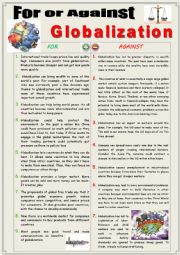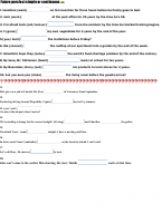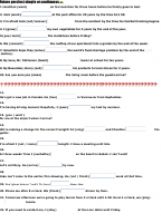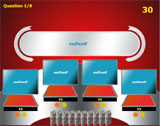
Simple Past or Past Continuous? - A communicative approach
Students look at the pictures under the headings "yesterday" and "yesterday at ... o�clock" and write mini dialogues - questions and answers - using both verb tenses. The vocabulary in the bubble at the bottom of the page will help them. KEY INCLUDED. You can make the exercise even more communicative by asking the students to do it in pairs, one as...
Level: elementary
Age: 9-12
Type: worksheet

Dialogues Series - asking for specific information (Wh-questions) for Intermediate or Upper elementary students
This is another worksheet with 2 short dialogues in which students practise wh-questions to communicate. We have to call students� attention to the importance of reading the answers carefully before trying to ask the questions. You may do the 1st one as an example with the whole class. Students roleplay the dialogues. A Black & White version is inc...
Level: intermediate
Age: 11-17
Type: worksheet

Active or Passive? (3) Multiple choice exercises (with KEY) in past simple
Download all my worksheets free at my website, http://iSLCollective .com, a worksheet-sharing site for ESL, DAF (German), ELE (Spanish), FLE (French) and Russian language teachers .............. Multiple choice exercises (with solutions). Tenses used: past simple. Students have to pick the one right sentence out of three that matches the picture be...
Level: intermediate
Age: 8-17
Type: worksheet

SIMPLE PAST OR PRESENT PERFECT TENSE
HOPE YOU LIKE.THANKS EVERYONE WHO WILL DOWNLOAD MY WS.
Level: elementary
Age: 10-17
Type: worksheet

Some or Any(2 pages) + Key
Pupils have to use the rules and look at the menus to complete the questions and answer them. Then complete the two bubles with some or any.
Level: intermediate
Age: 9-14
Type: worksheet

PRESENT SIMPLE OR PRESENT CONTINUOUS?
Four exercises to practise Present Simple and Present Continuous.
Level: elementary
Age: 9-12
Type: worksheet

passive or active
It�s a useful worksheet to let your students undrestand the difference between ACTIVE and PASSIVE voice.and Actuallt I prepared it for PRE INTERMEDIATE students. Hope you like it :)
Level: intermediate
Age: 9-17
Type: worksheet

BOTH...AND / NEITHER...NOR / EITHER ...OR
A ws to practice on linking words "both and, either or, neither nor.
Level: elementary
Age: 14-17
Type: worksheet

Grammar worksheet on 3 Verb tenses: Simple Present, Present Continuous and Be going to Future for Upper Elementary or Lower Intermediate students
This is the way I usually choose to make my students practise the use of these 3 verb tenses at the same time, because I really think it makes the rules quite clear for routines/everyday actions (SPres,), for what we�re doing at the moment (PCont.) and for what we�re going to do later (Be going to future). Students can roleplay the dialogue at the ...
Level: intermediate
Age: 10-14
Type: worksheet

adjective or adverb
They choose the correct option.
Level: elementary
Age: 9-17
Type: worksheet

Simple past or past continuous ?
2 pages: lesson + activities (mixed tenses, questions, time markers...)
Level: intermediate
Age: 11-17
Type: worksheet

For or against Globalization (DEBATING)
Well, here�s another worksheet aimed at debating. Students are first asked to brainstorm on the subject, what globalization evokes to them ! Then, I give them the worksheet (with the pros and cons) which I leave them explore in pairs. The ws is mainly composed of pros and cons aimed at helping ss to take position on the subject and also buildin...
Level: advanced
Age: 15-100
Type: worksheet

A little .. A lot of .. A few ..
A little .. A lot of .. A few ..
Choose the correct answer..
Level: intermediate
Age: 3-17
Type: worksheet

SOME or ANY
Here is one more worksheet to review the use of SOME and ANY, so easy and yet so complicated! KEY included. (Images by Philip Martin)
Level: intermediate
Age: 8-17
Type: worksheet

COUNTABLE OR UNCOUNTABLE -WORDSEARCH (B&W VERSION INCLUDED)
Students unscramble the words, wirte if they are countable or uncountable and finally find them in the wordsearch. I hope you like it and find it useful. Have a wonderful evening/day. Hugs!
Level: elementary
Age: 10-17
Type: worksheet
|

A OR AN? - ACTIVITIES - KEY INCLUDED
ENUMERATE THE ACTIVITY IT IS LATER WRITE "A " OR " AN " ACCORDING TO THE CASE.I HOPE BE USEFUL. THANKS AND HUGS.
Level: elementary
Age: 5-17
Format: PowerPoint

True or False
It can be used as a competition in groups.It is a very big ppt so I have to send it in 6 parts.
Level: intermediate
Age: 10-17
Format: PowerPoint

both either neither
it�s a powerpoint where students can practice these structures: both...and, either...or, neither...nor
Level: intermediate
Age: 14-17
Format: PowerPoint

A or AN BOARDGAME !!!!!!!!!!!!!!!!!!!! !!!!!!
Have fun !!!!
Level: elementary
Age: 3-17
Format: PowerPoint

Spelling Game
a Power point game to practice the spelling of some of the most confusing words in English.
Level: intermediate
Age: 14-17
Format: PowerPoint

British English & American English
To go along with this: http://www.eslprinta bles.com/printable.a sp?id=767232#thetop worksheet.
Level: intermediate
Age: 10-100
Format: PowerPoint

BELIEVE IT OR NOT!
Students have to decide if the presented statements are true or false. Some of them are deliberately controversial and the answers are quite unexpected because they don�t seem to go by any logical explanation. I�ve personally used this presentation as a booster in one of my speaking classes. Also, the ss may try to explain their decisions. Unfortun...
Level: intermediate
Age: 13-100
Format: PowerPoint

Expressing lack or understanding and asking for clarification
Expressing lack or understanding and asking for clarification lesson and practice
Level: intermediate
Age: 12-100
Format: PowerPoint

Some - Any
Here is "Some - Any" presentation: basic explanation and an exercise.
Level: elementary
Age: 7-17
Format: PowerPoint

TOO OR ENOUGH?
TOO HAS A NEGATIVE MEANING. ENOUGH HAS A POSITIVE MEANING. CHECK THE MODELS AND EXERCISES AND LEARN HOW TO USE THEM. HOPE YOU ENJOY!
Level: elementary
Age: 12-17
Format: PowerPoint

How Much or How Many
Exercises to practice countables and uncountables.
Level: elementary
Age: 13-17
Format: PowerPoint

Some Difficulties of the English Pronunciation
A useful powerpoint to discuss some difficulties of the English pronunciation :)
Level: intermediate
Age: 12-17
Format: PowerPoint

Adjective or Adverb
It�s a ppt about the difference between an adjective and an adverb. It includes exercises as well.
Level: intermediate
Age: 12-17
Format: PowerPoint

Modals of obligation
Presentation explaining the modals of obligation (must, mustn�t, have to, don�t hav to, should and shouldn�t). Examples and explanations with images, hope you find it useful!
Level: intermediate
Age: 5-17
Format: PowerPoint

A, a, or no article Part 1
A pwp to practice a / an or no article (Part 2). Thanks to Philip Martin for his cliparts.
Level: elementary
Age: 7-17
Format: PowerPoint
|

colors
colors
Level: elementary
Age: 4-100

Present Perfect Simple or Continuous
Complete the sentences with the correct form of present perfect simple or continuous
Level: intermediate
Age: 12-100

Present Perfect Simple or Continuous
Complete with the correct form of future perfect simple or continuous
Level: intermediate
Age: 12-100

Future perfect simple or continuous
Complete with the correct form of the future perfect simple or future continuous
Level: intermediate
Age: 12-100

LEARNING A FOREIGN LANGUAGE(2)
There are twenty sentenses to use the words correctly discussing the topic "Learning a Foreign Language"
Level: intermediate
Age: 12-14

vocabulary 4th grade
adjectives
Level: elementary
Age: 5-8

VERBS! CAN OR CAN�T
CAN OR CANT?
Level: elementary
Age: 8-100

Noun, adverb, adjective or verb
Students have to say the sentences for the last question. All or nothing.
Level: intermediate
Age: 10-100

weeer
dfdfdf
Level: advanced
Age: 7-9

Abstract nouns
Guess the abstract nouns
Level: intermediate
Age: 11-14

Easy vocabulary
To help you learn basic vocabulary
Level: elementary
Age: 3-5

Guess the Word or Sentence
Guess the Word or Sentence
Level: elementary
Age: 5-12

Country
It is a fun game to learn about countries.
Level: elementary
Age: 14-100

countries
Different countries of the world
Level: elementary
Age: 14-100

Homophones
Complete the sentences using the correct homophone
Level: elementary
Age: 7-9
|